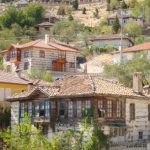Old name: Lyrbe

High in the hills above Manavgat lie the austere but romantic ruins of Seleucia in Pamphylia lost amid pine trees whose sighs sound like running water. Once access was via a rough track but in the summer of 2012 this was tarmacked as far as the ruins of the city gate where trees were also cut down to improve visibility.
Not much is known about Seleucia, a city probably founded by Seleucus I Nicator (r. 321-280 BC) that eventually became part of the Roman Empire. Its original name, Lyrbe, was Luwian. (Some archaeologists now think that this was the separate site of Lyrbe while Seleucia was down on the coast.)
The most impressive surviving part of what must once have been a large Roman town is is the agora with parts of a hefty Doric colonnade still in place and a small odeon/bouleterion and temple opening off from one side. The walls of what George Bean identified as a market hall survive in places to two storeys, making them especially impressive. 
Beyond the agora another small temple survives with two trees growing inside it along with the remains of what may be a bathhouse.
Everything here looks as if it was built to last with little decoration, and door and window-frames consisting of huge unadorned slabs of stone.
Transport info
Dolmuşes will only get you from Manavgat (13km) to the village of Buçakşeyhler (Sıhlar), leaving several km to walk but a growing number of jeep safaris and coach tours from Side (19km) include Seleucia in their itineraries.
 Naras KöprüsüIf you’re going to hire a taxi from Manavgat make sure the price is not inflated to cover a rough road that has since been smoothed over.
Naras KöprüsüIf you’re going to hire a taxi from Manavgat make sure the price is not inflated to cover a rough road that has since been smoothed over.
Ask to stop on the way at the main Manavgat waterfall which, while a tourist trap, is still very beautiful.
Beyond the waterfall look out on the left for the pretty stone-built Naras Köprüsü (bridge) with what looks like a tower attached to it – it’s beside the large Şirince tea garden.
As you near Seleucia you will pass several stretches of the ruined Roman aqueduct that used to bring water to the town from near Side. Some stretches are quite close to the road.



